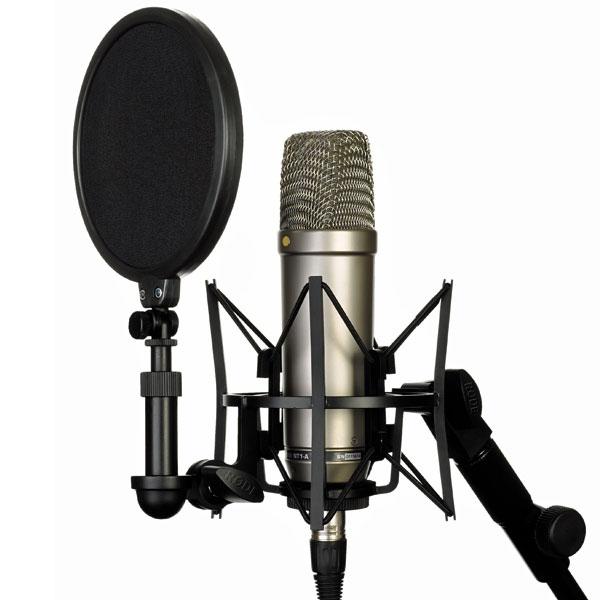It is often taught that “sound is vibrations in the air.” We are able to enjoy music because we sense these vibrations in the air as sound.
Microphones convert these vibrations into electrical signals. Here are the two main types of microphone:
Dynamic Microphones
Characteristics:
- Construction is simple and comparatively sturdy.
- No power supply is required.
- Relatively inexpensive.
Condenser Microphones
Characteristics
- Good sensitivity at all frequencies.
- Power supply is required.
- Vulnerable to structural vibration and humidity.
So then which one is right for you?
Condenser microphones may have greater appeal because they have “good sensitivity at all frequencies”. However, they are not always the most practical choice.
Often during recording, a “pop shield” filter is required to protect against noise caused by the vocalist’s breath hitting the condenser microphone. This is because condenser microphones are able to react to more subtle sounds. On the other hand, condenser microphones are not suited for high-volume recording, so dynamic microphones are mainly used in situations where loud audio is to be picked up.
Condenser microphones are used with PA systems in cases where a wide band of frequencies, ranging from low to high, is to be picked up for choir vocals, acoustic pianos, hi-hat cymbals (which are known for their sensitive and high frequency), or for use “overhead” to pick up sounds from the entire drum set.
The chart below is a display is of polar patterns of some microphones
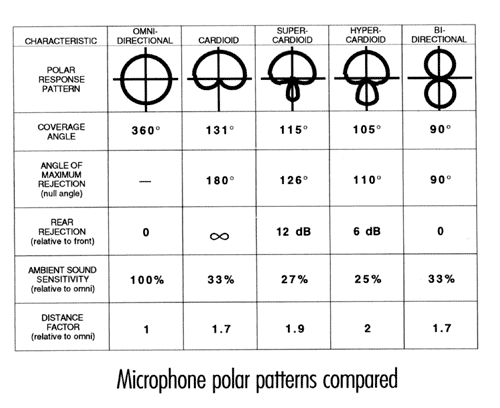
So let’s break it down into just three of the patters for now.
Cardiod (Some would say unidirectional or directional but that is not quite correct)
![]()
This type of microphone features directionality to the front only and is also known as “cardioid” (because of its heart shaped directional pattern). Cardioid mics are most often used with PA systems for vocals, instruments, etc. In the diagram, 0°indicates the front of the microphone.
Bidirectional – Also called the figure eight
![]()
This type of microphone features directionality to the front and rear. Because bidirectional microphones will also pick up audio to the rear, they are rarely used with PA systems. They are often used to record audio between two people who are face to face, such as during radio interviews.
Omnidirectional
![]()
As mentioned above, this microphone type has no directionality. “Omni” mics are used to pick up all or wide range audio. For example, they are used for choirs, when many instruments are played at once, or to pick up all audio on the stage.
So what Microphone is right for you depends on what you plan on using you microphone for.
There are three common types of microphones utilized in music.
Dynamic:
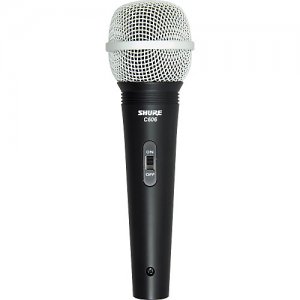
If you’re looking for something reliable and versatile, then you ought to start with dynamic mics. Thanks to their moving coil magnetic diaphragm, these mics reliably capture sound and can do so even at high sound pressure levels. As such, you can use them for miking loud sound sources like bass and guitar amplifiers, and even drum kits without worrying about unwanted distortion or damage. Finally, they are not just for high SPL (Sound Pressure Level) applications because they work quite well in quieter settings.
Condenser:
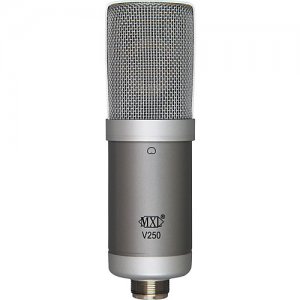
Condenser mics have a thin conductive diaphragm that sits close to a metal backplate. This configuration works like a capacitor wherein sound pressure vibrates the diaphragm which in turn changes the capacitance to produce the audio signal. Since they use capacitance instead of actual moving coils, fidelity and sound quality is improved, making these mics ideal for precision recording in the studio. Note that this method of sound capture requires power, so you’ll need a mixer or direct box with phantom power (except in cases where batteries are used). Whatever instrument you are trying to record, condenser mics will get the job done so long as the sound pressure levels aren’t too high. Just remember to handle them with care as they are not as sturdy as dynamic mics.
Ribbon:
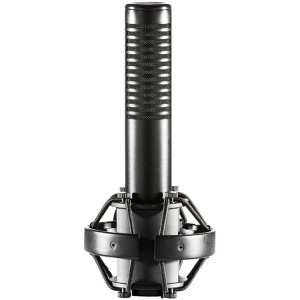
While these mics are no longer as popular, Ribbon mics were once very successful particularly in the radio industry. The light metal ribbon used in these mics allows it to pickup the velocity of the air and not just air displacement. This allows for improved sensitive to higher frequencies, capturing higher notes without the harshness while retaining a warm vintage voicing. These days, interest for Ribbon mics have returned, especially since modern production ribbon mics are now sturdier and more reliable than their old counterparts, making them viable for live multi-instrument recording on venues where noise level is manageable. You can also use them for recording if you’re looking for vintage vibe, or you can set it up in combination with dynamic or condenser mics for a more open sounding track.
We’ve talked about the main types of microphones you’ll use in various situations, however as you gain experience you’ll also learn how to break with convention.


